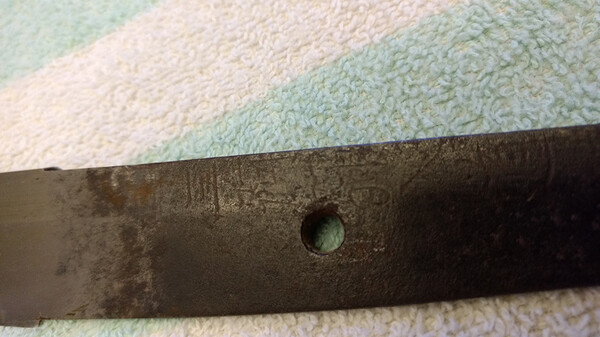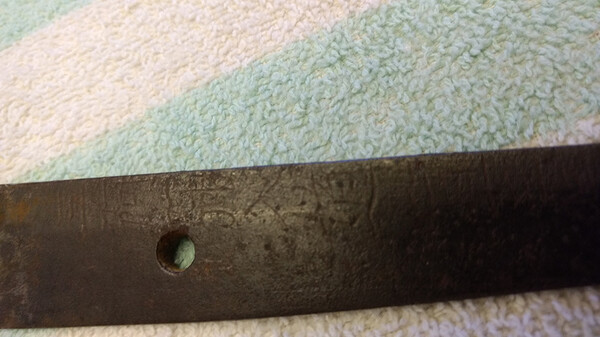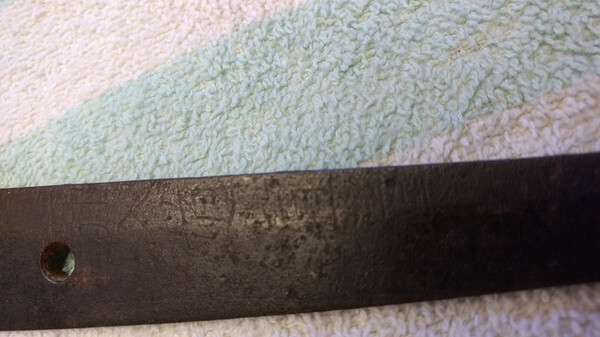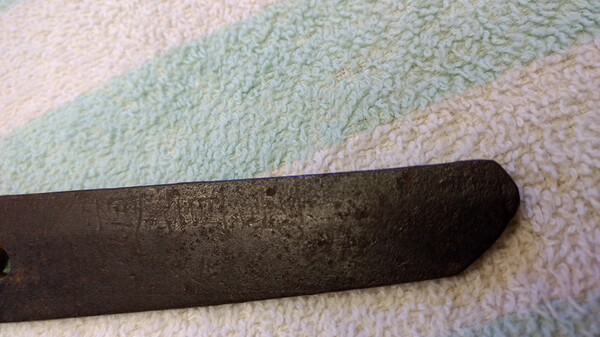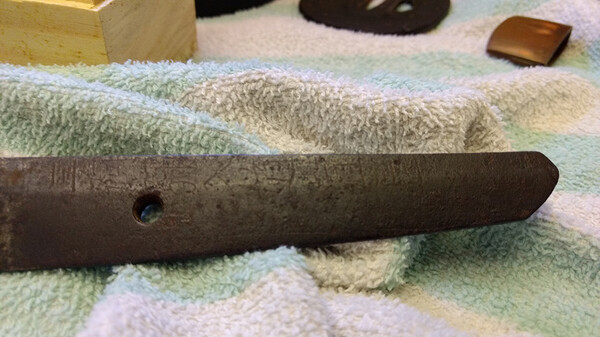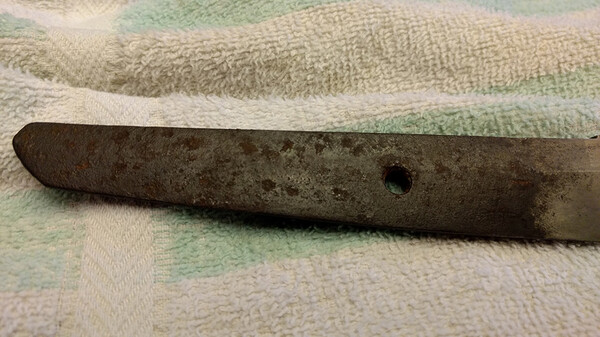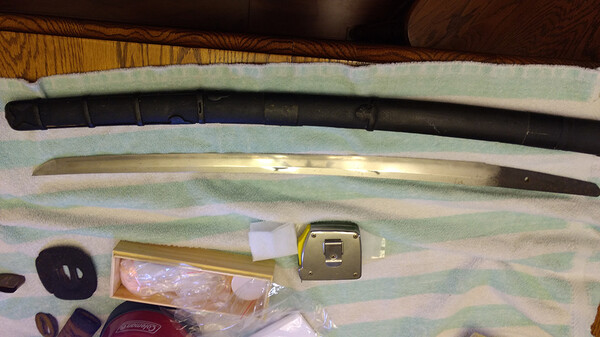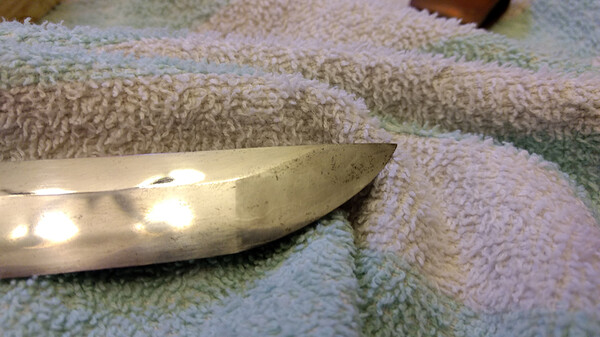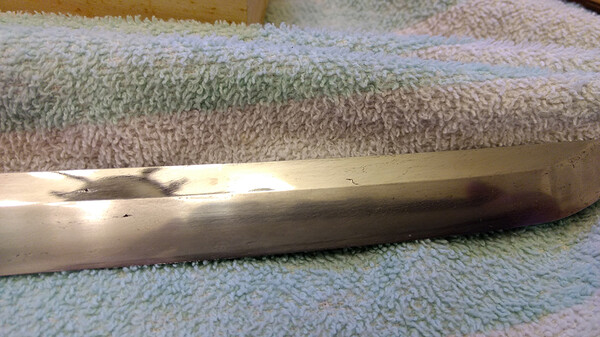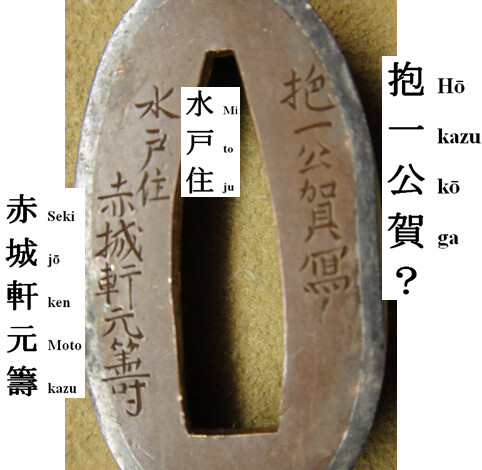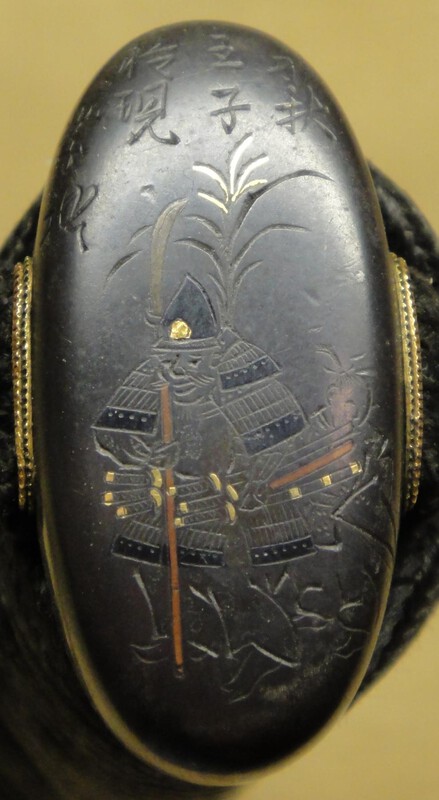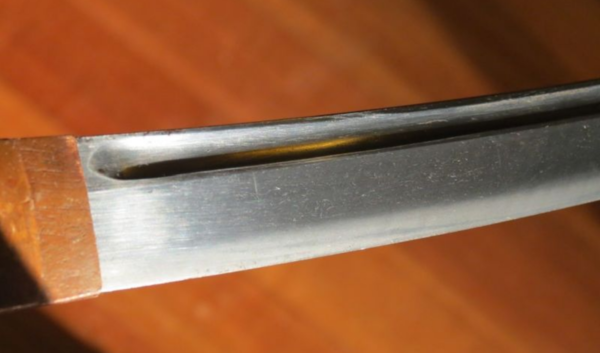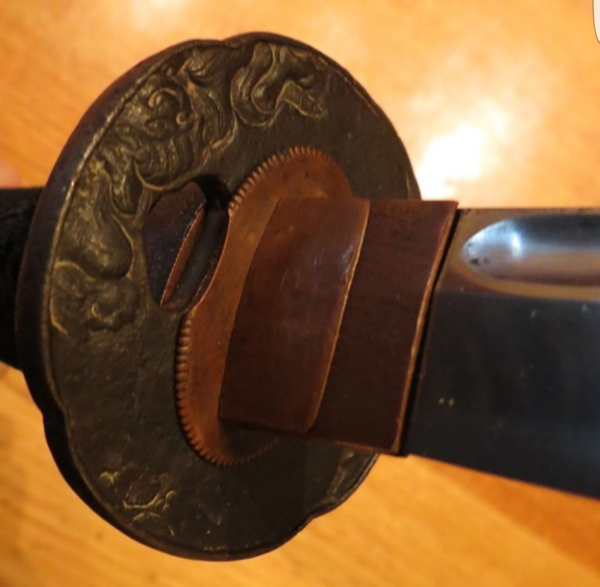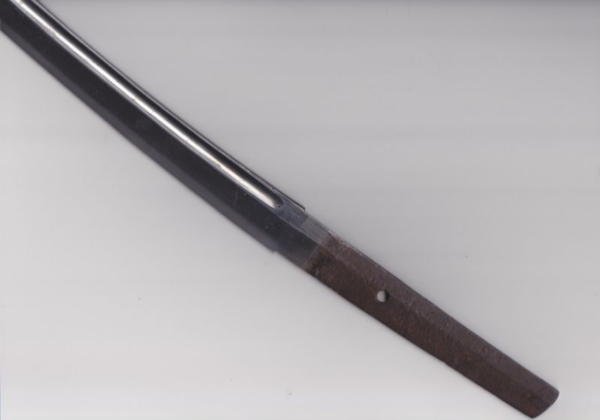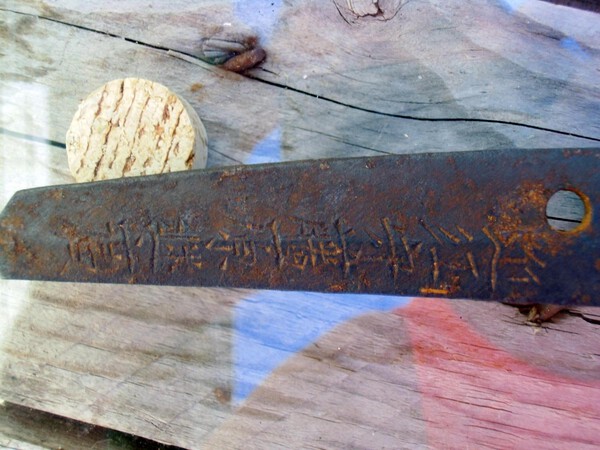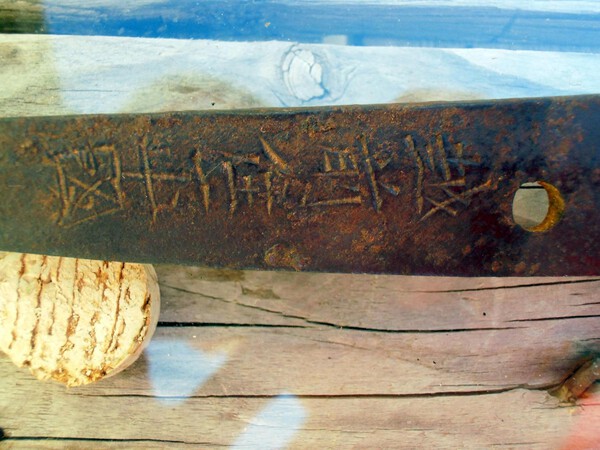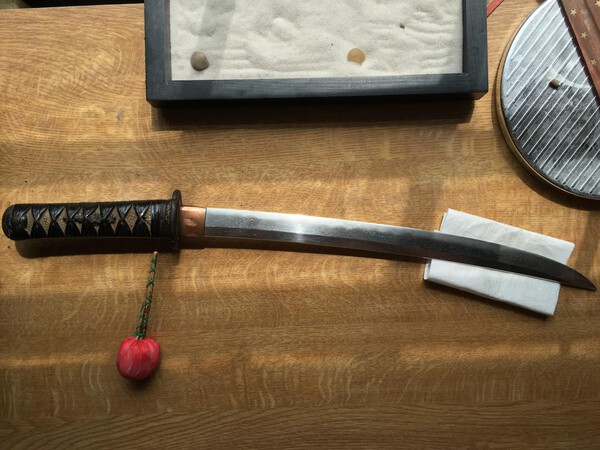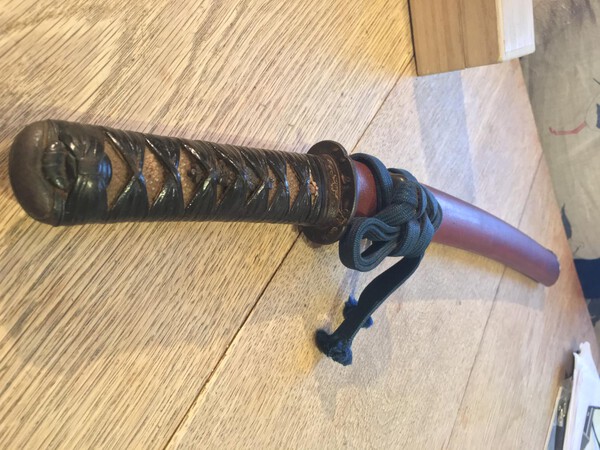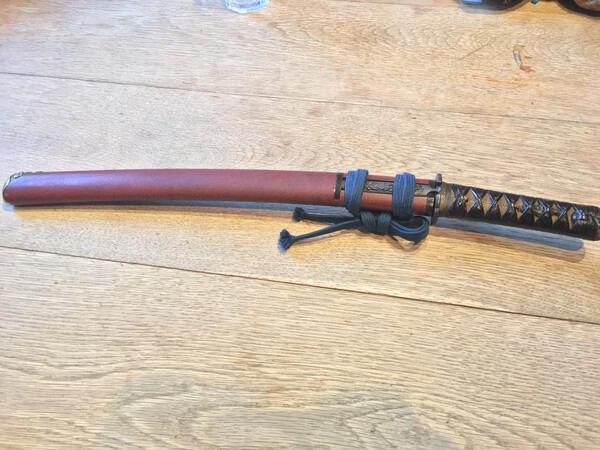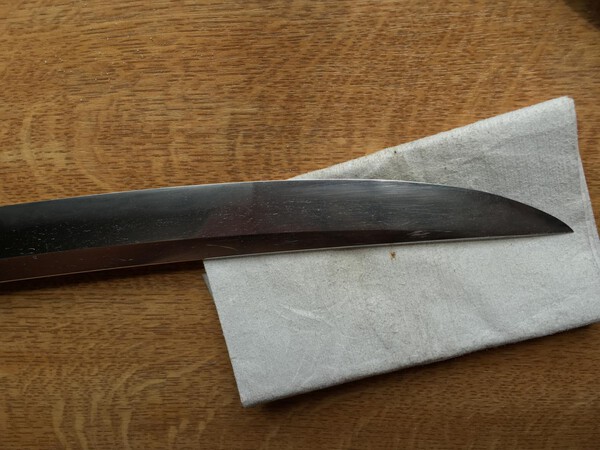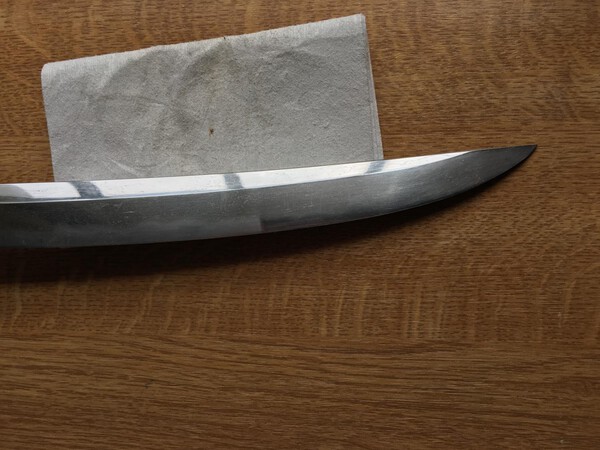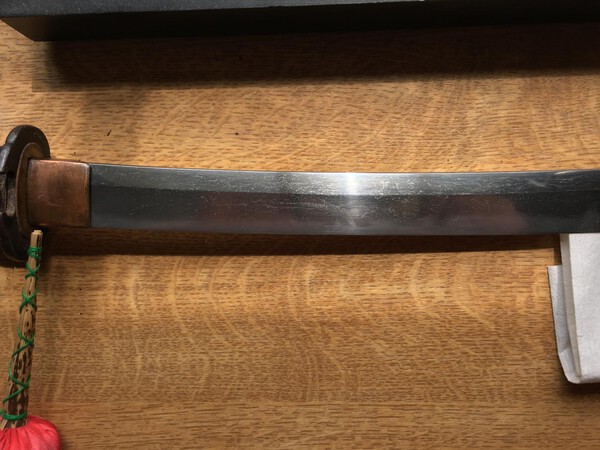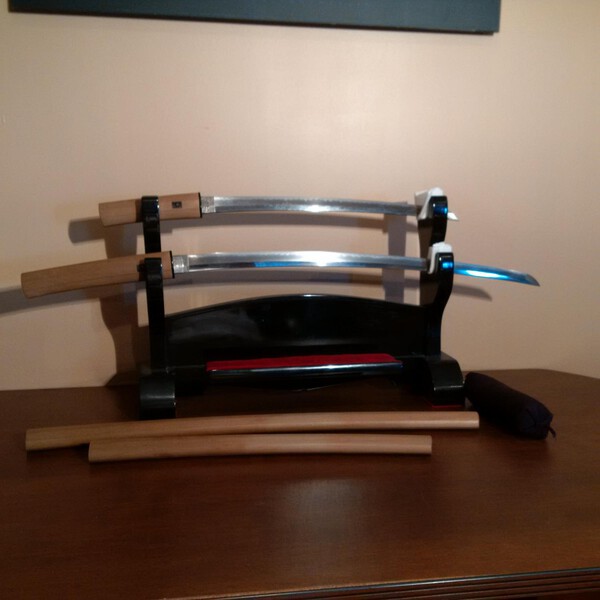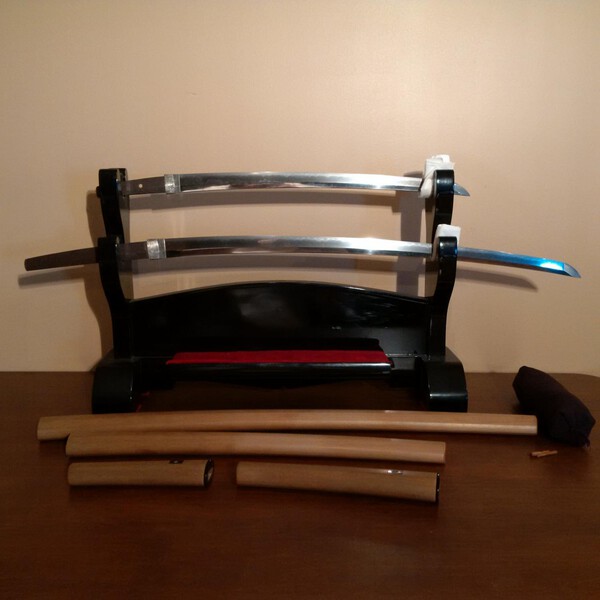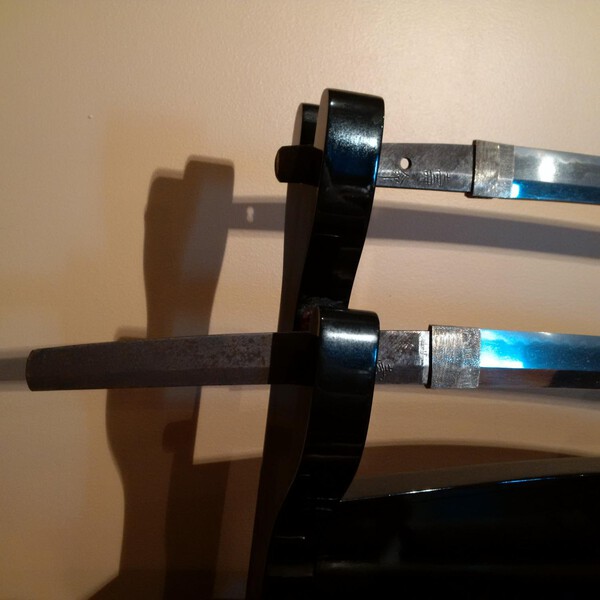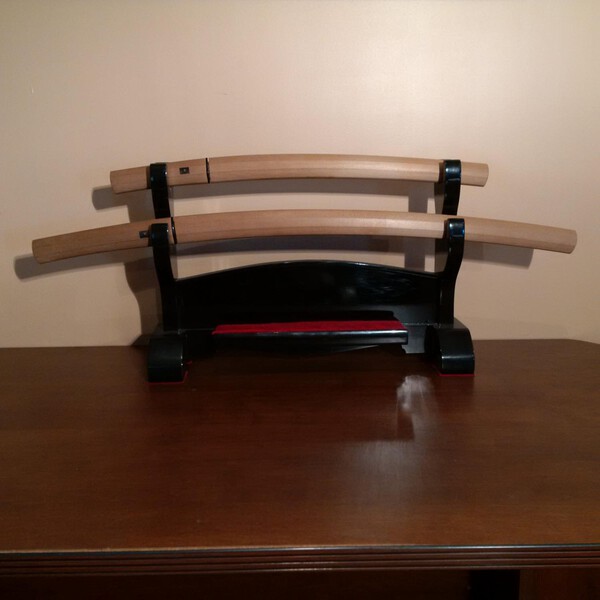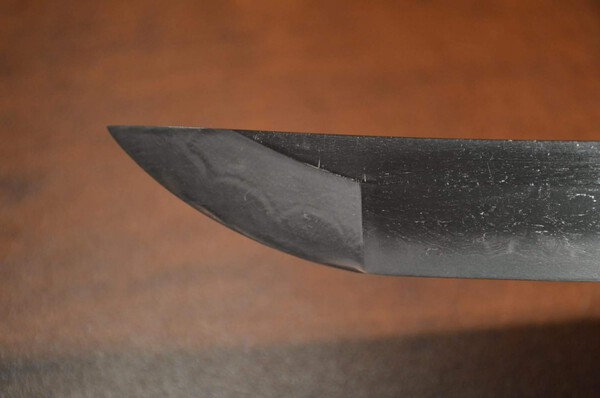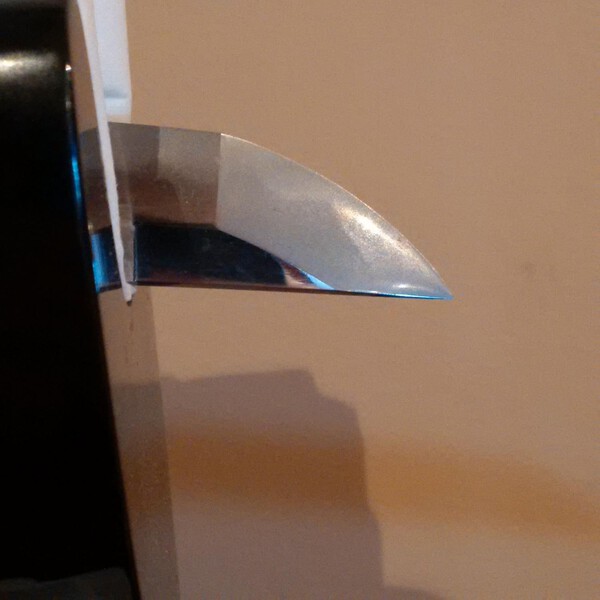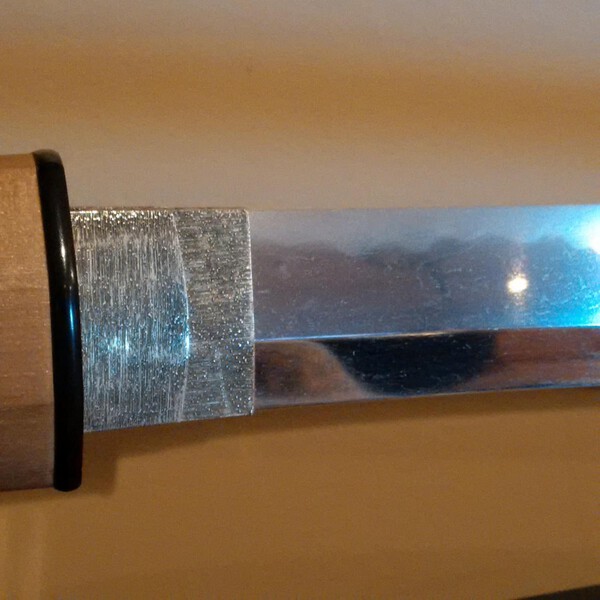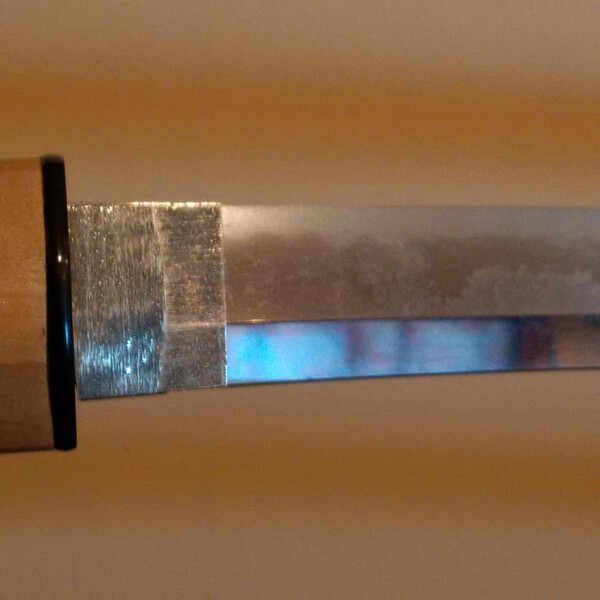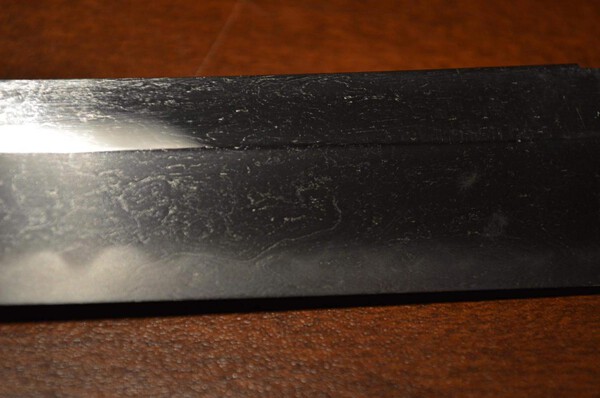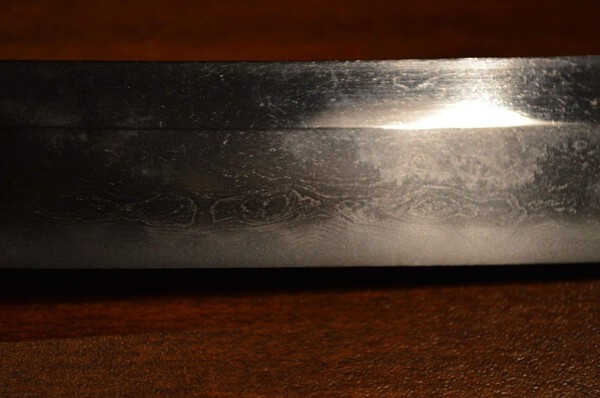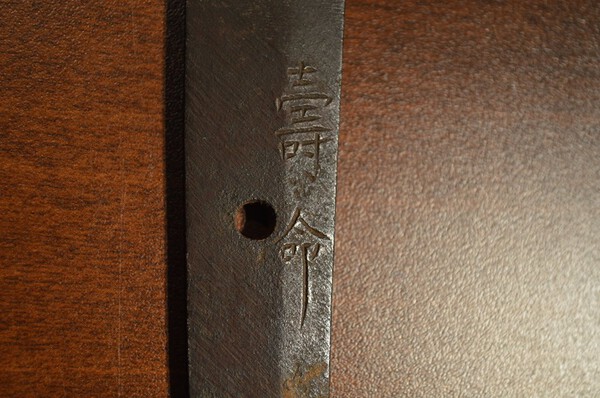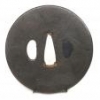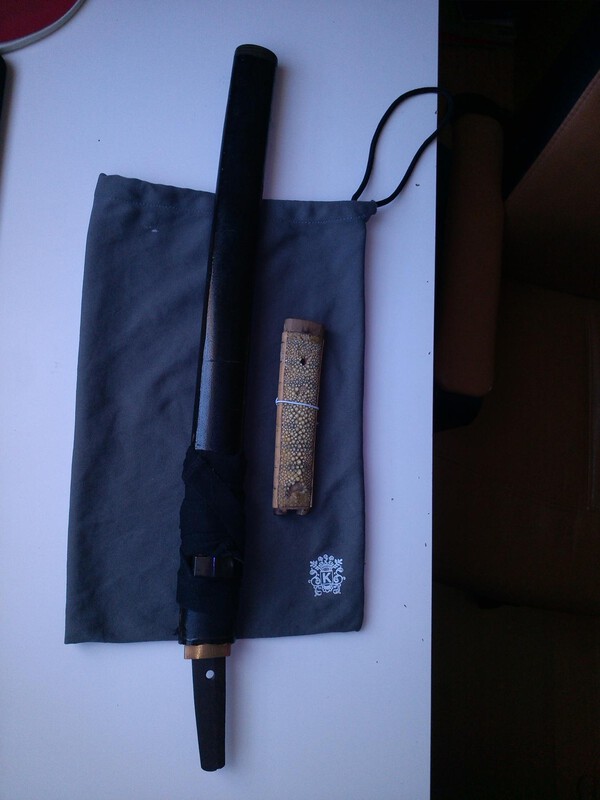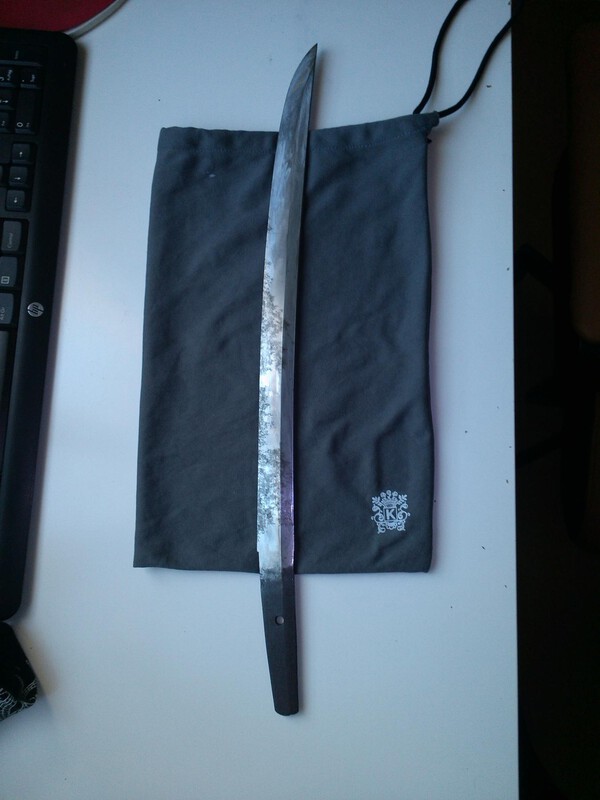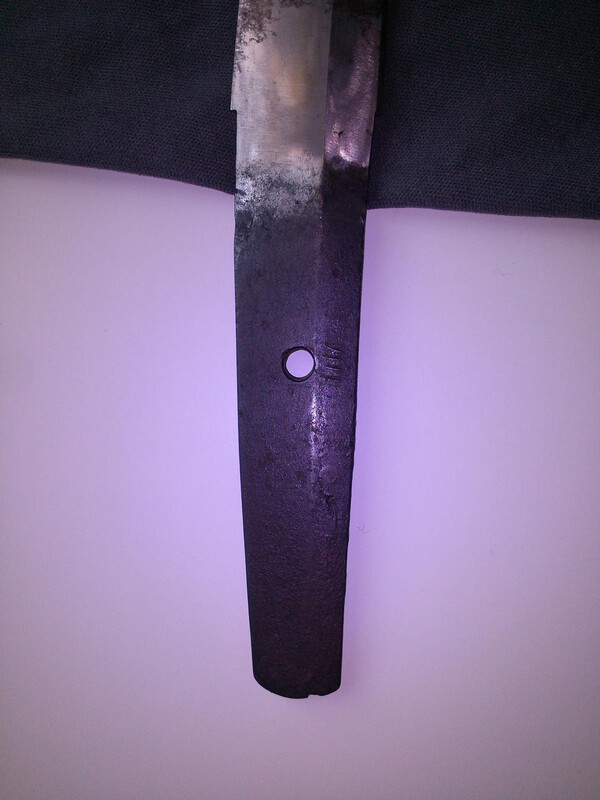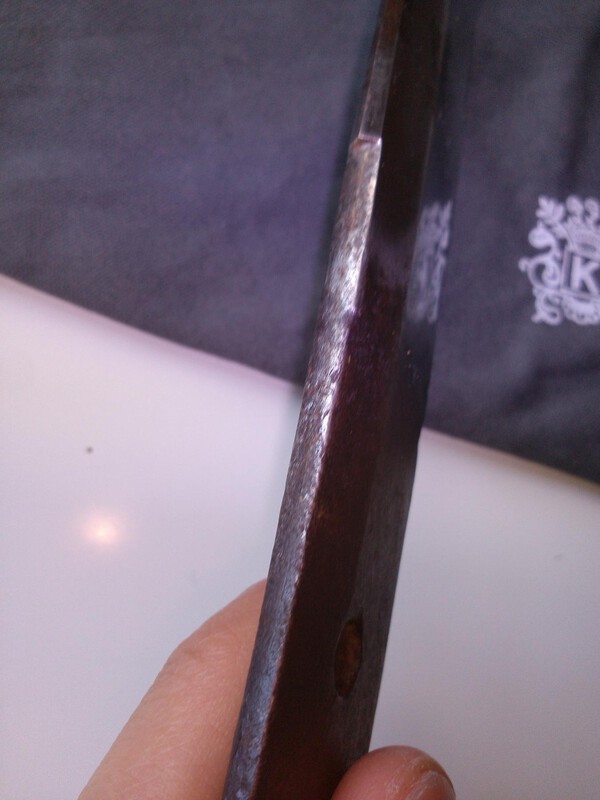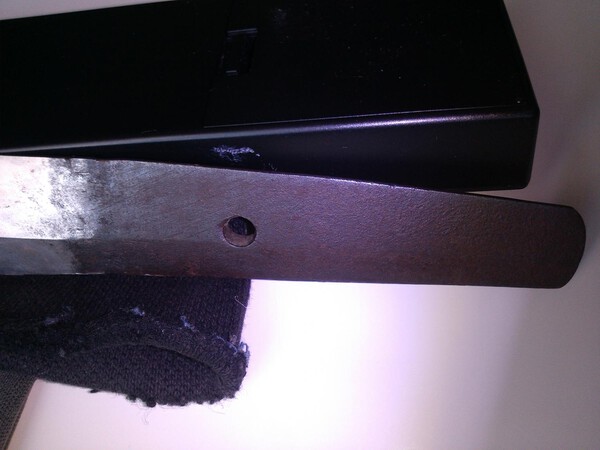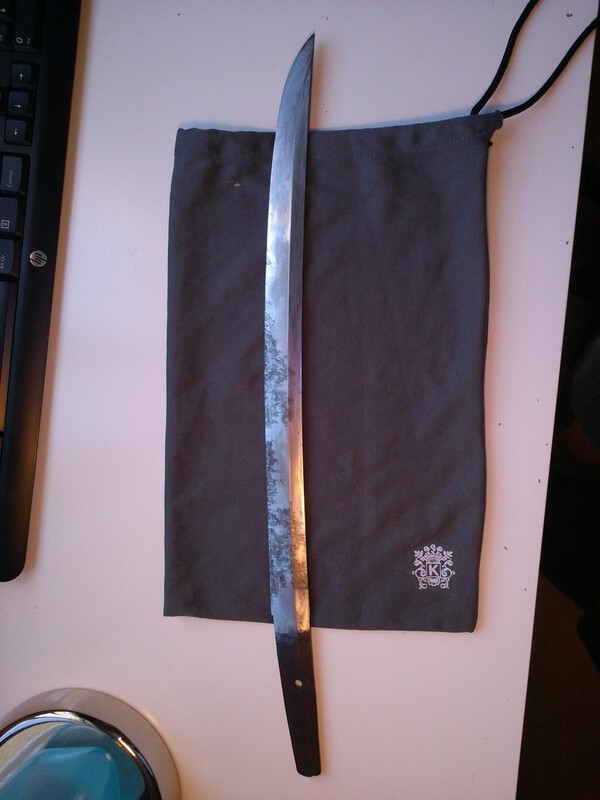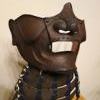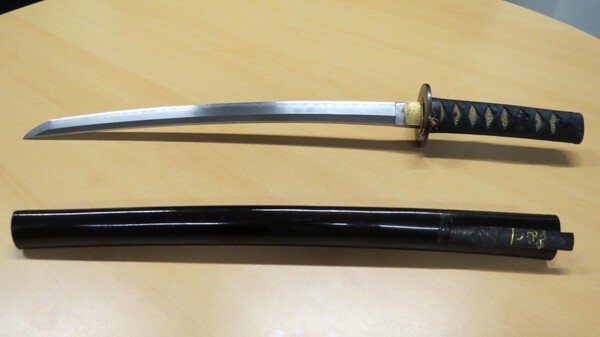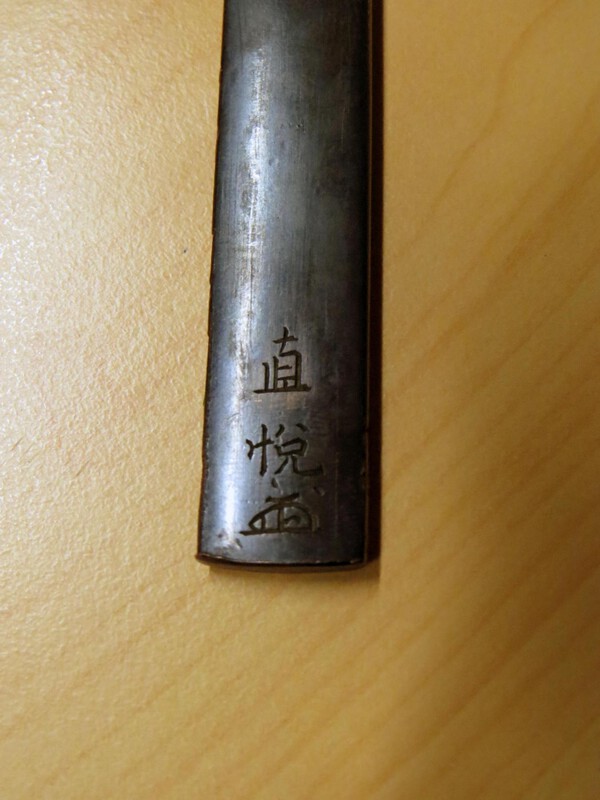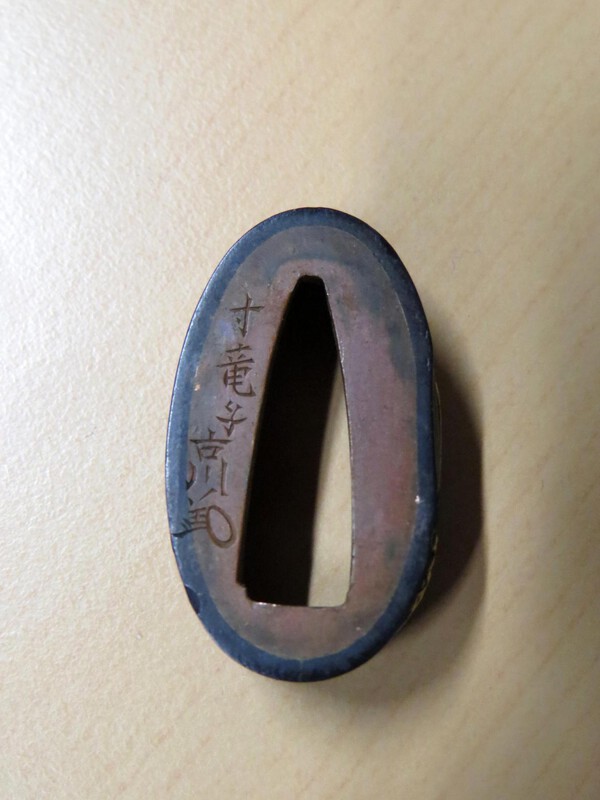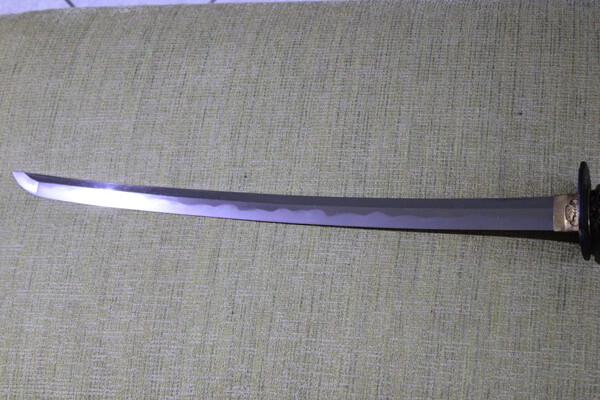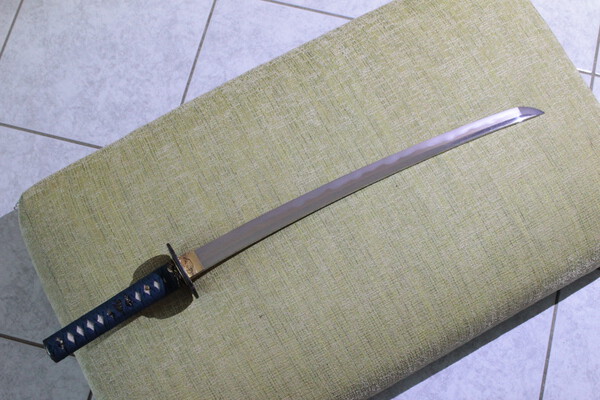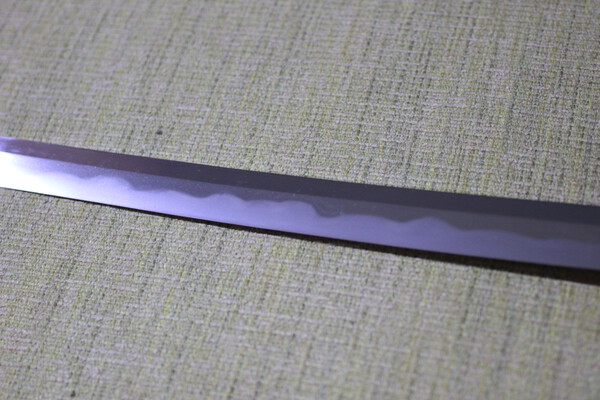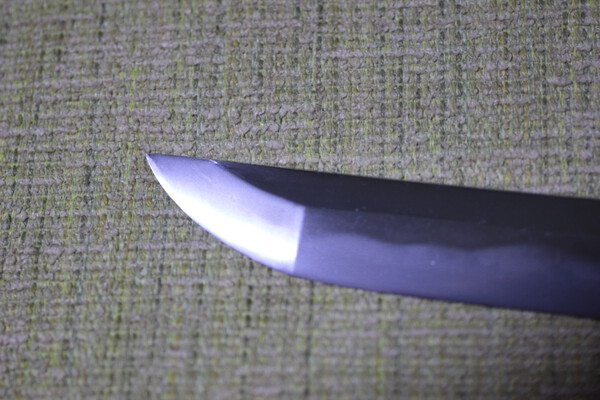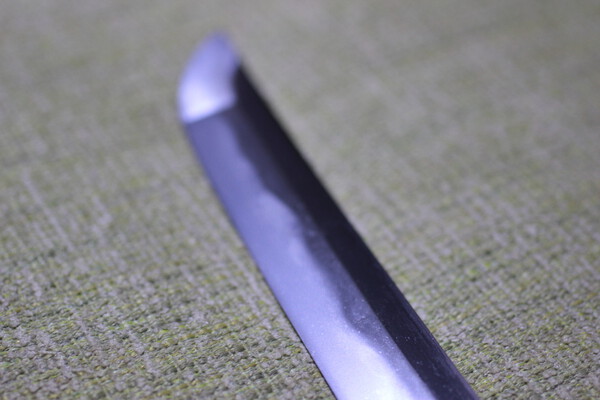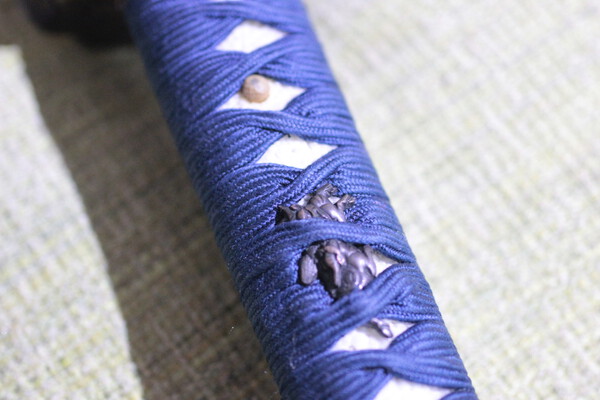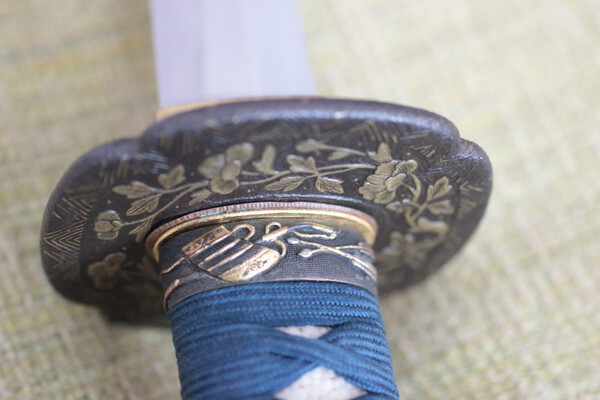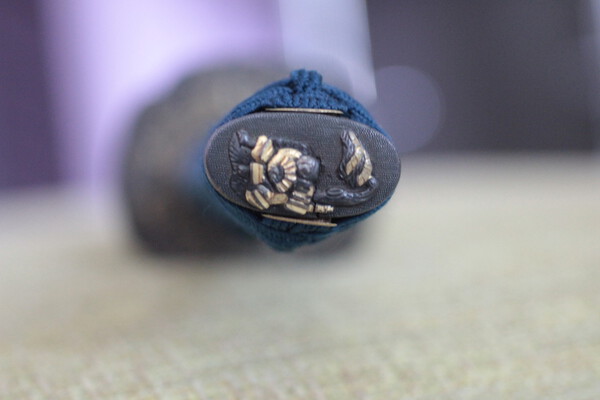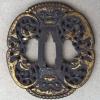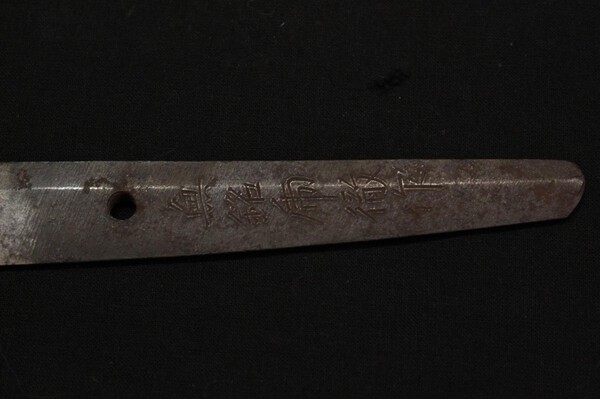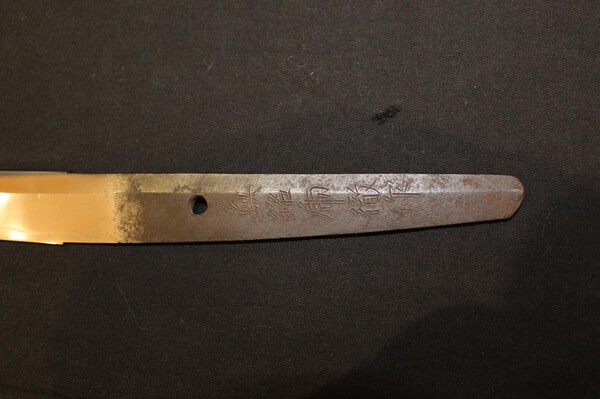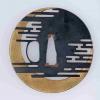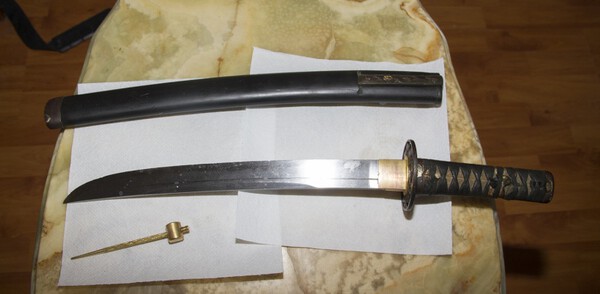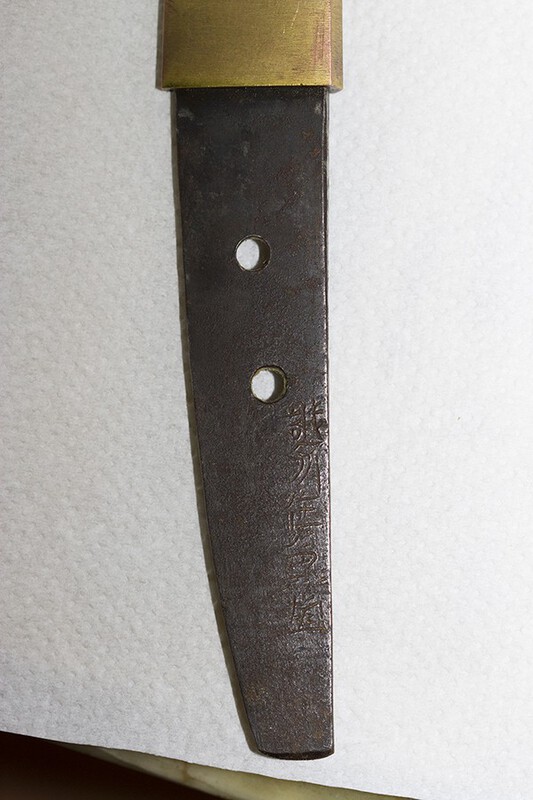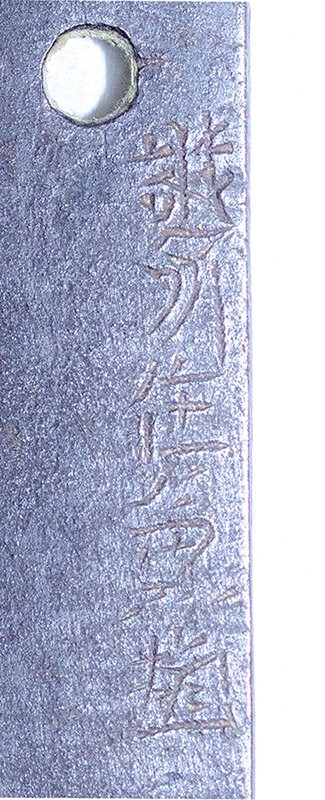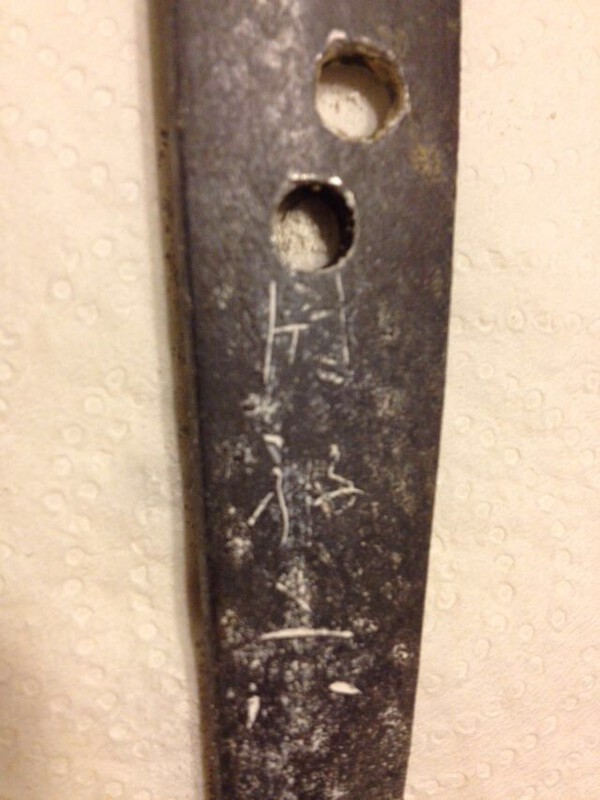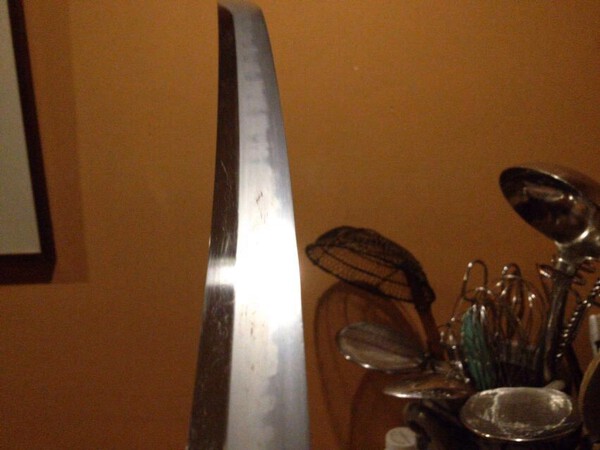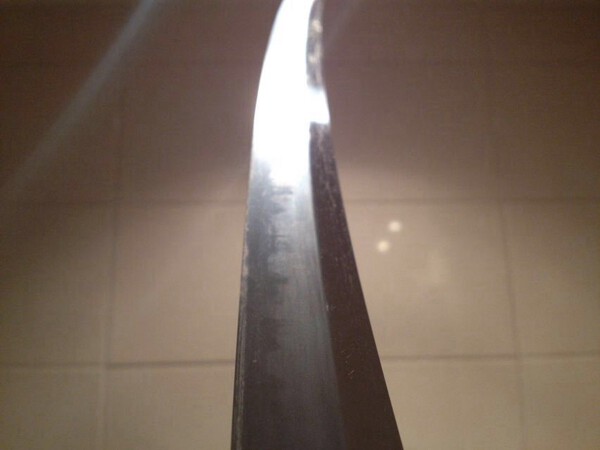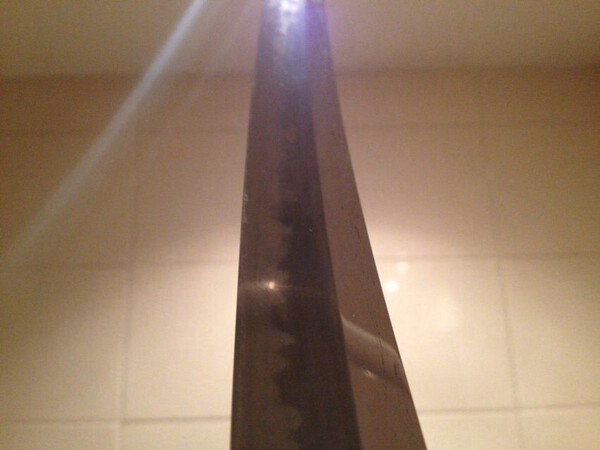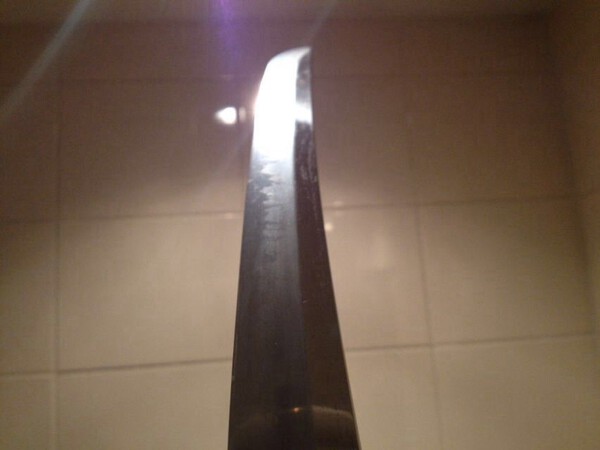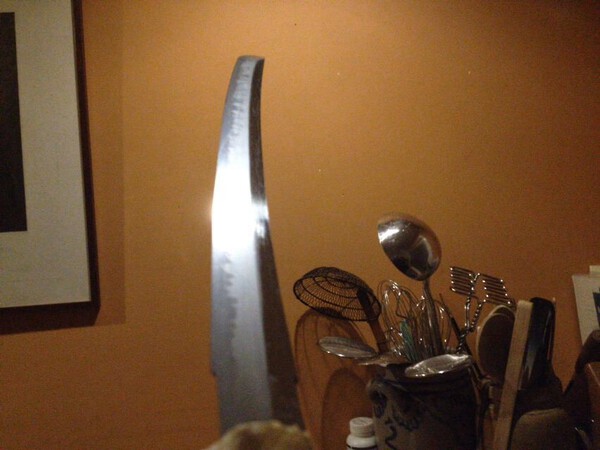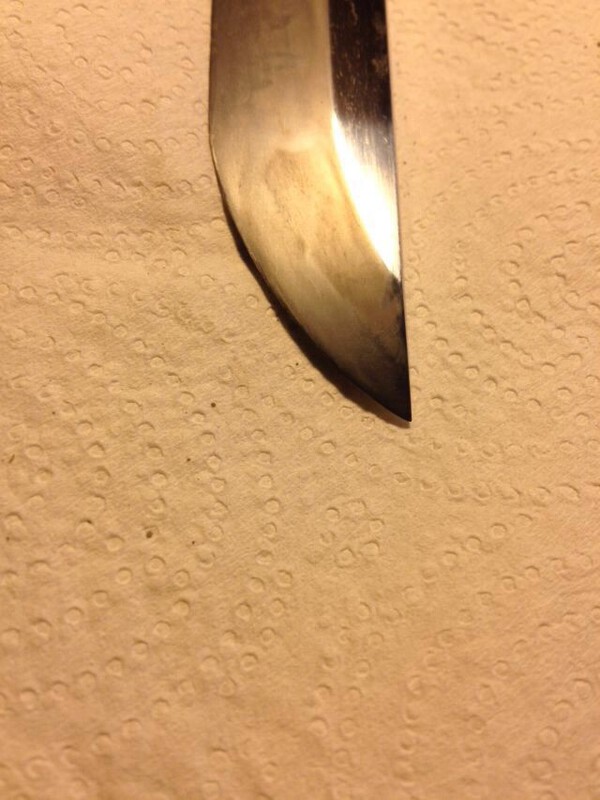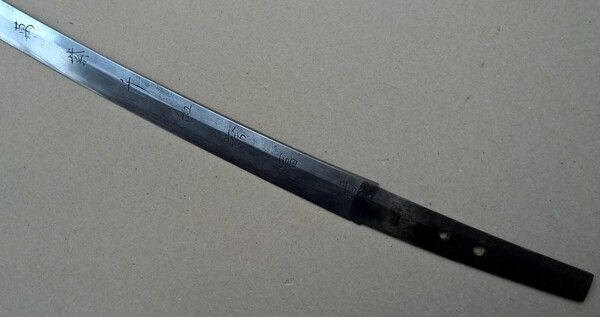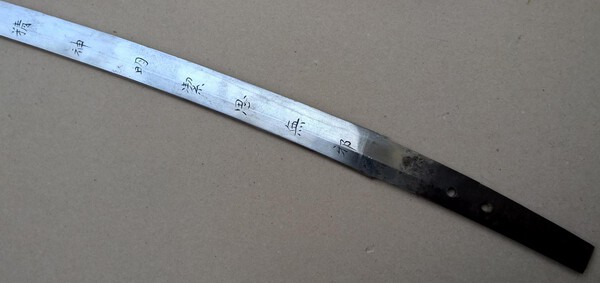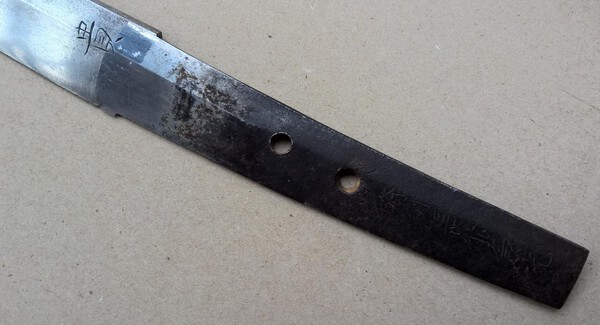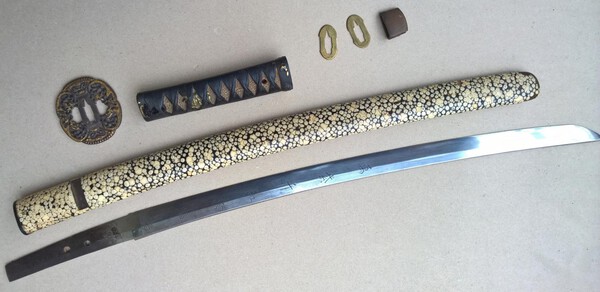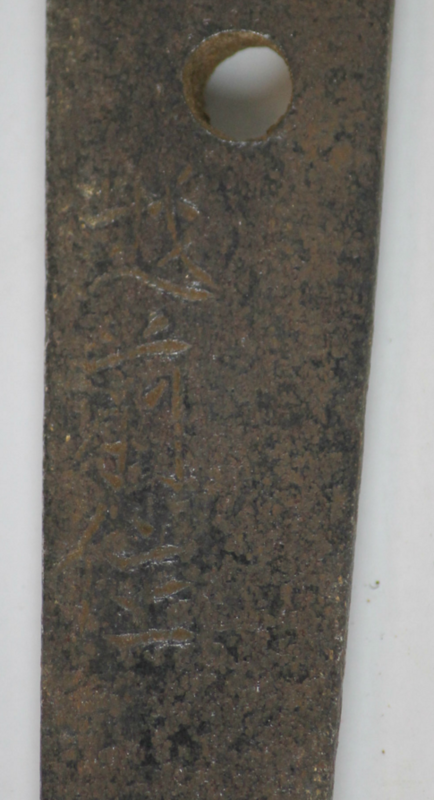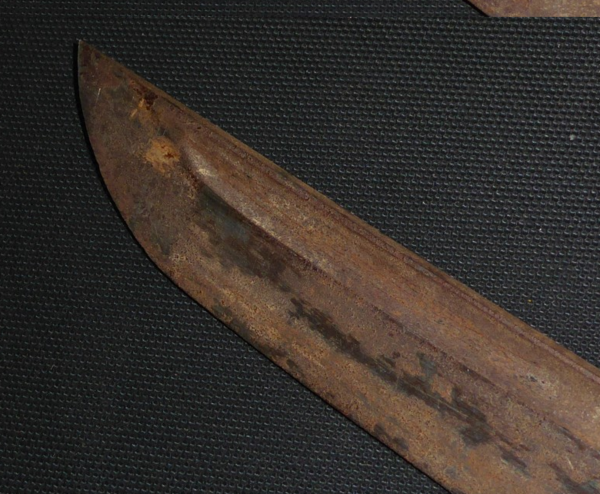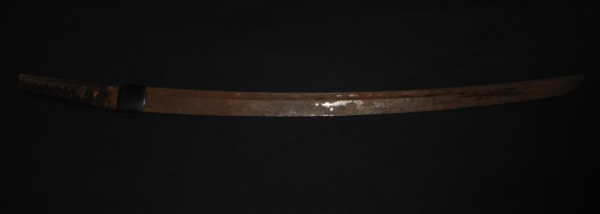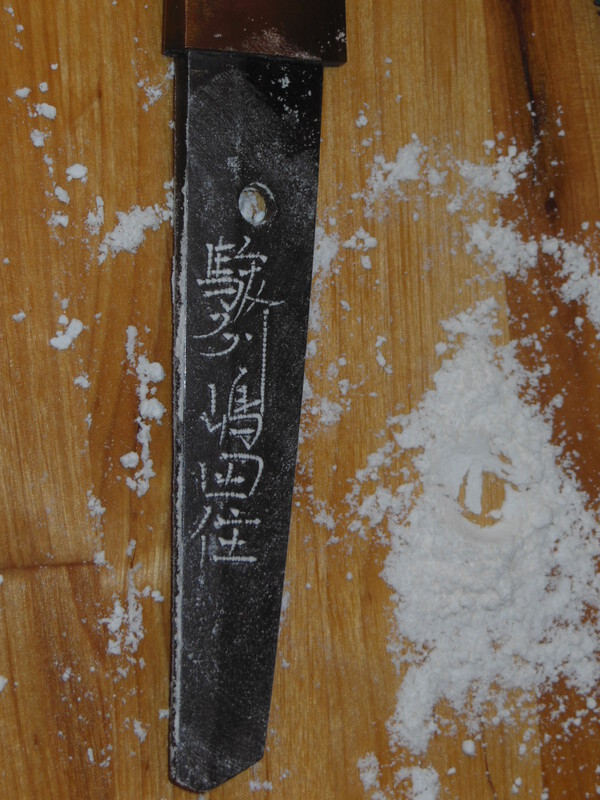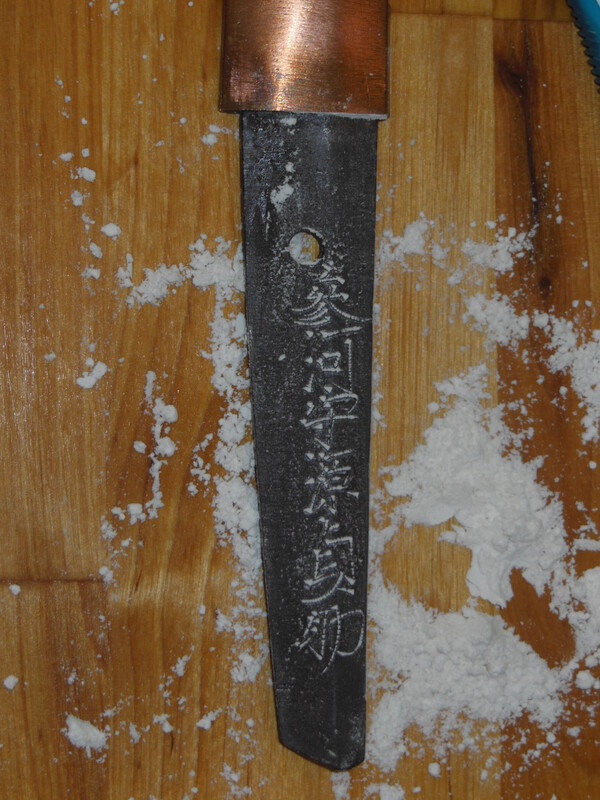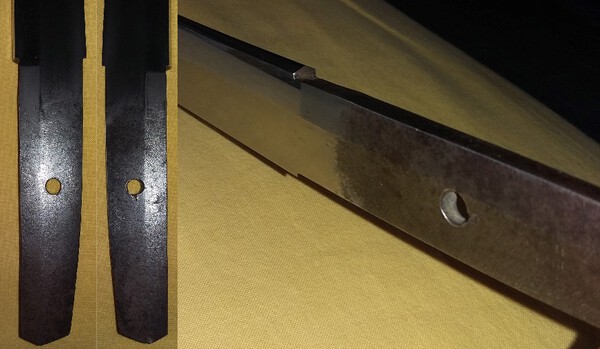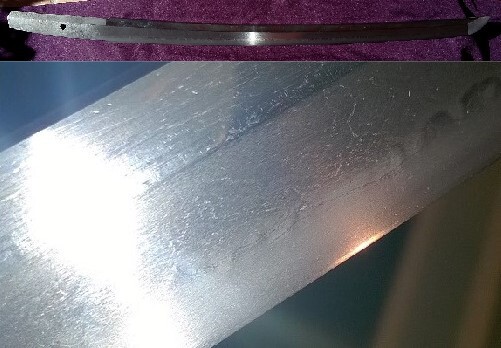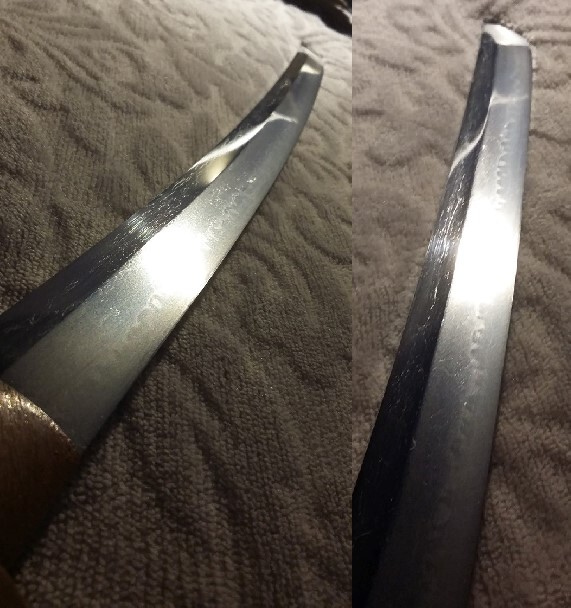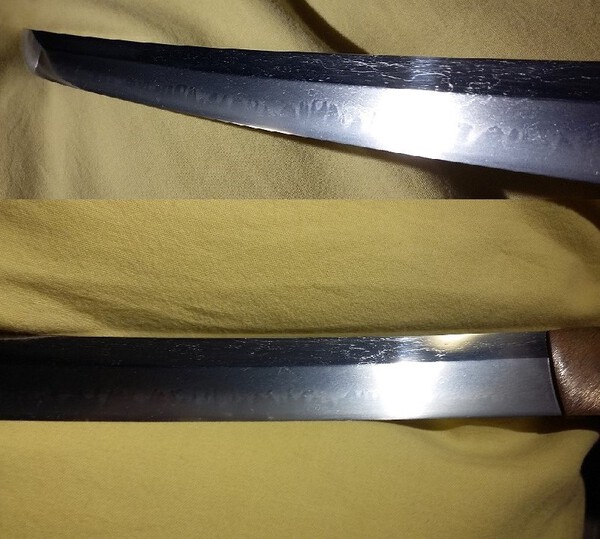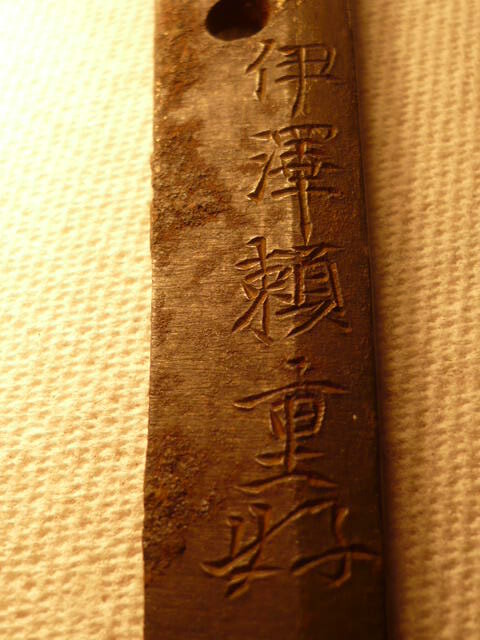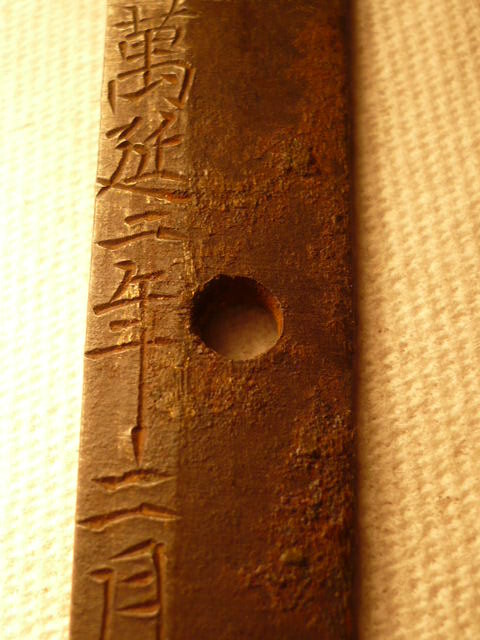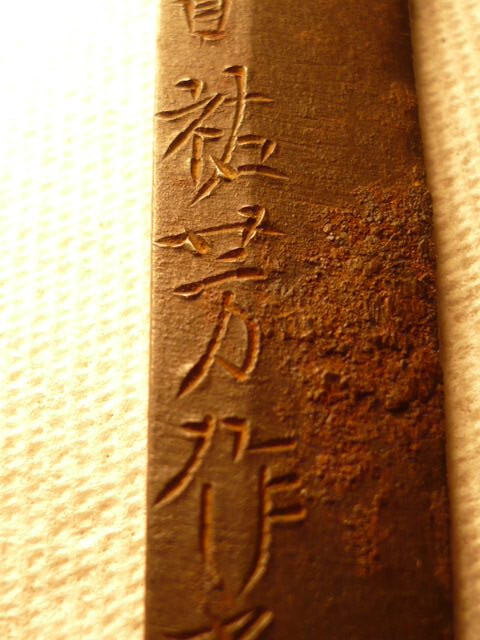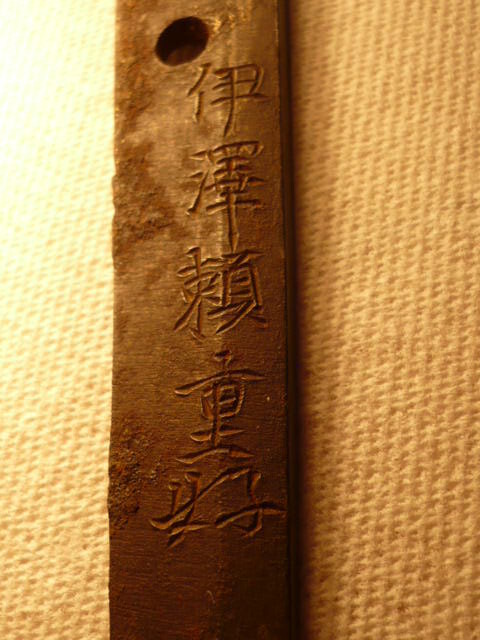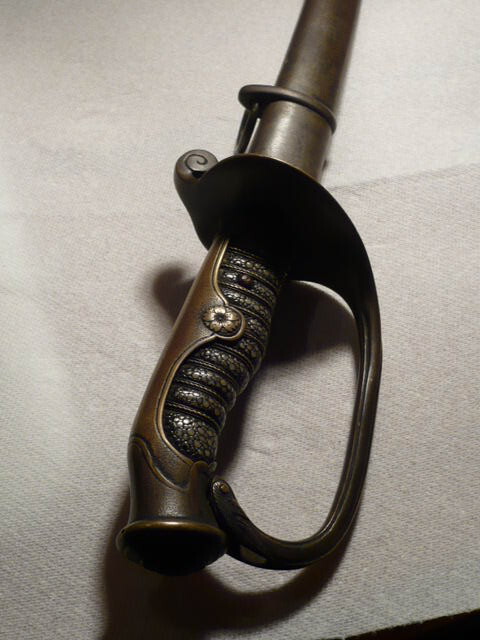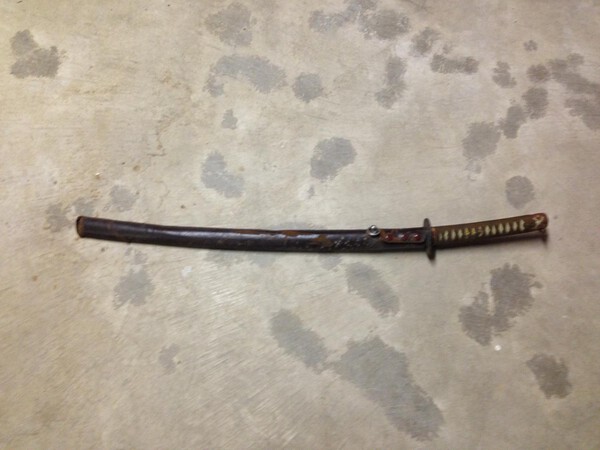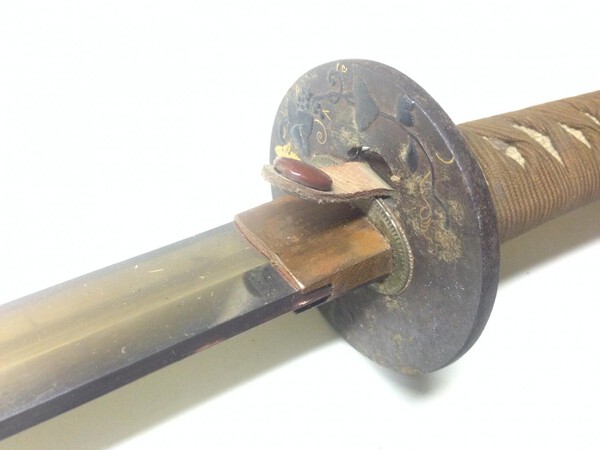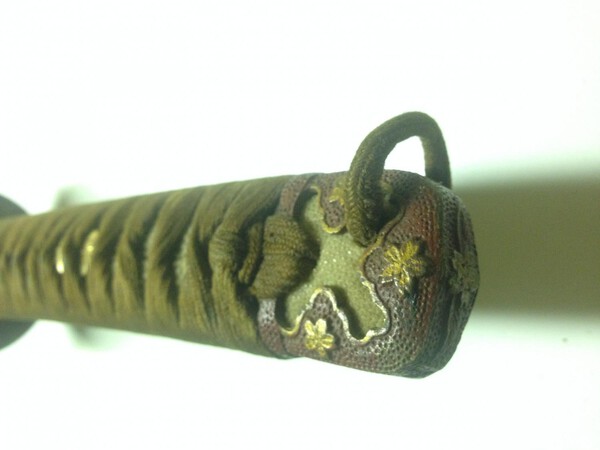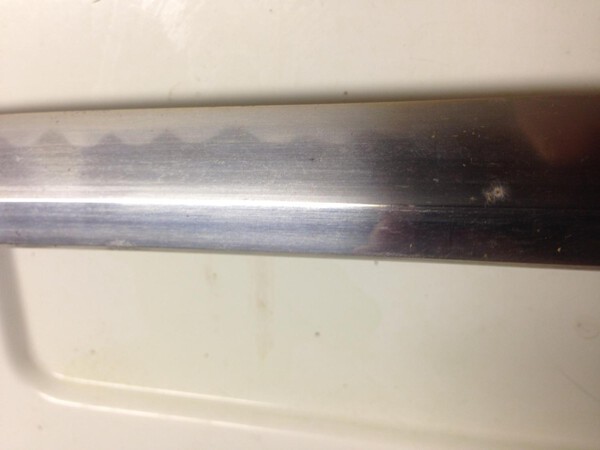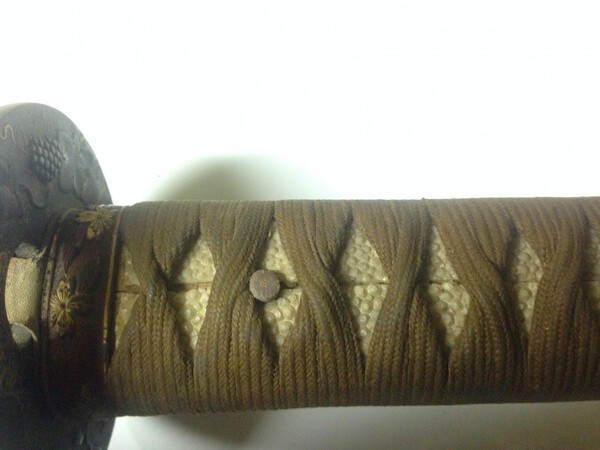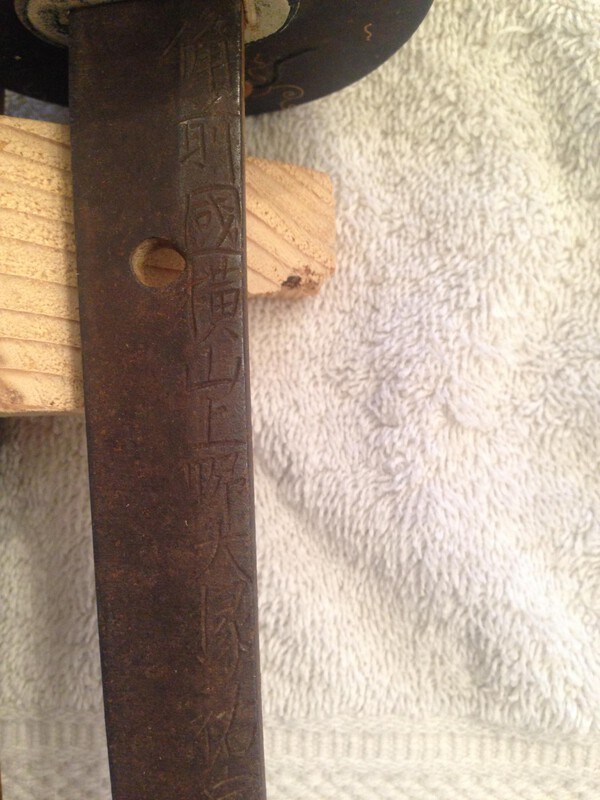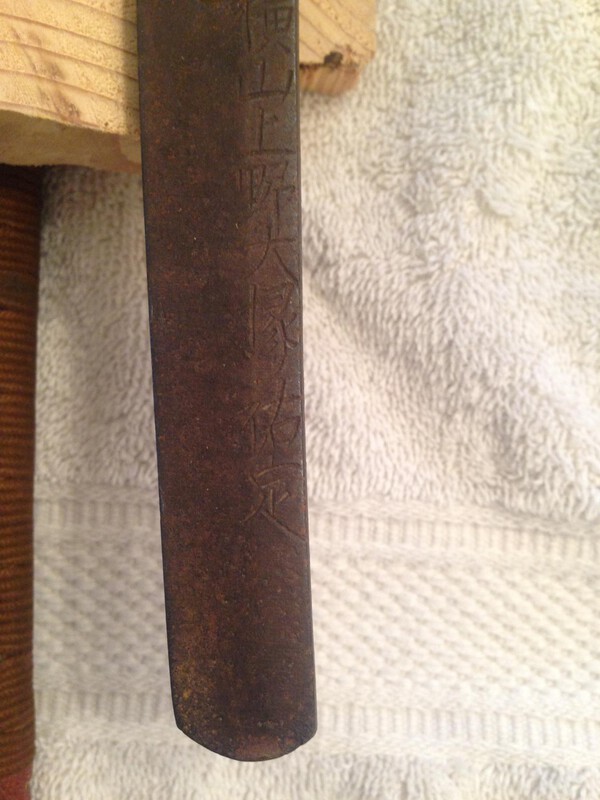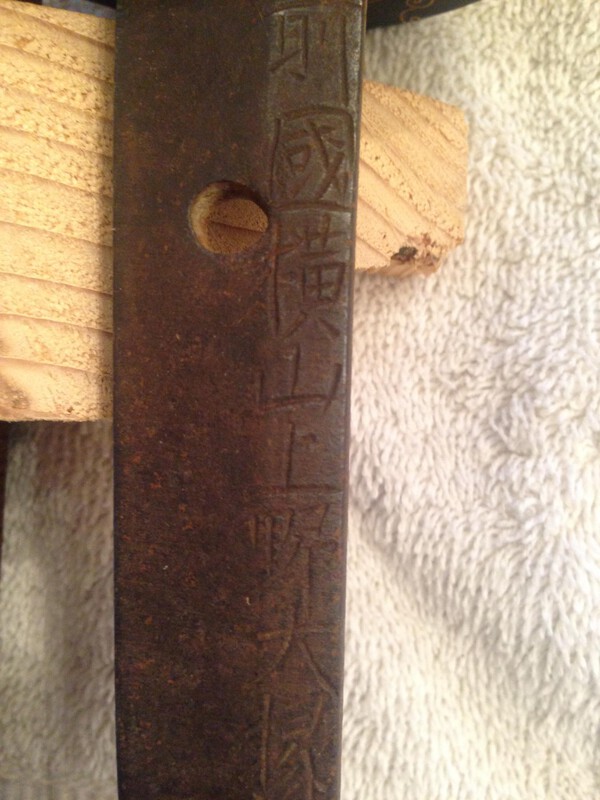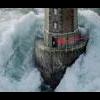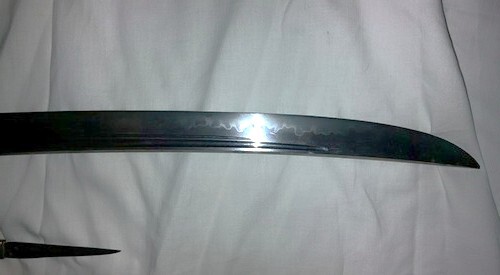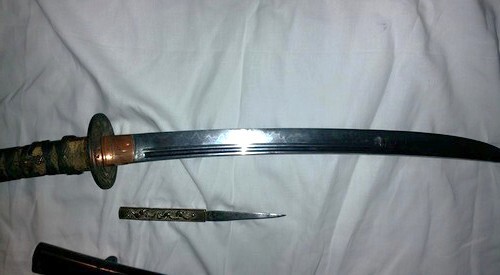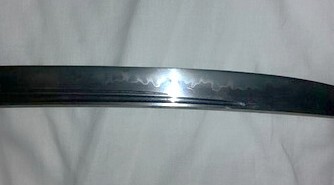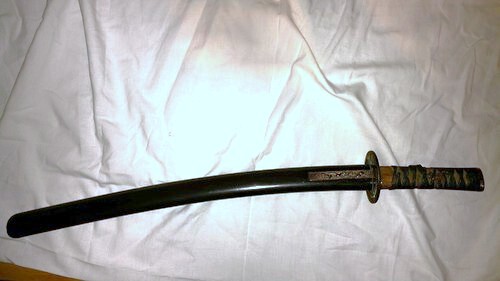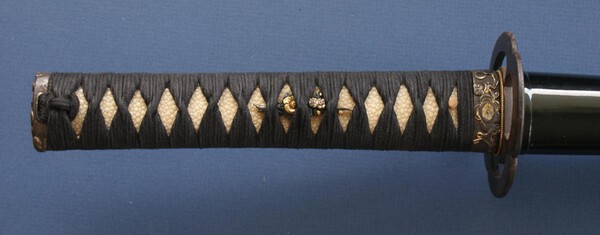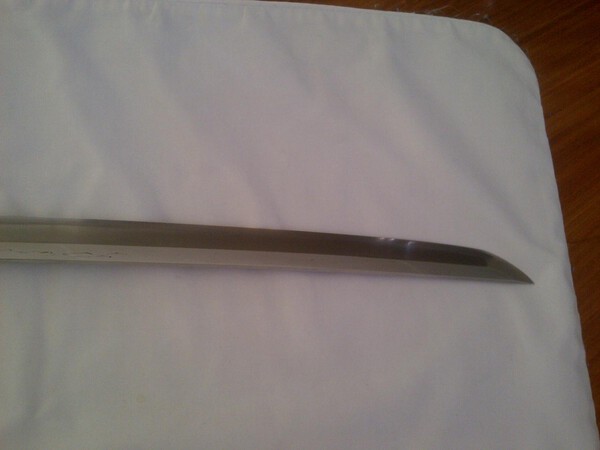Search the Community
Showing results for tags 'wakizashi'.
-
Hello, I recently acquired a sword and I am having difficulty with the Mei. I received this in on trade and will be keeping it just wanting to know any details. Thanks Bruce
-
Dear All I bought a mounted wakizashi (O-tanto) at the Minneapolis sword show. The Shinogi-zukuri blade with high shinoji is 12 ¼ inch (31.1 cm) long with a gunomi midare in nio hamon. The fuchi is signed by Mito ju Sekijōken Motokazu (H05878.0). I think I have identified some of the kanji on the right hand side but I am unsure what they mean? Any thoughts? Also there are 5 kanji on the side of the fuchi and 8 kanji on the kashira. I am unsure what any of these kanji are. Thoughts? The fuchi has a red gourd with maple leaves and the kashira has a samurai with a naginata? Is there a story here? If more images are needed please let me know. Thanks for any help David jswords@mcn.net
-
Hi all, just thought I'd post pics of a Sadatsugu (I'm told)53cm nagasa wakizashi, Sorry about pics all i got. I'm looking 2 add this one shortly 2 the lot, and would like 2 know more about it. Comments all good, thanks Details not 2 good in pics Mark L
-
Hello, I am new here, and looking for translation on a wakizashi. It has no Shinsa with it and was wondering if someone would be kind enough to give me a translation and maybe some information on the sword smith. thanks
-
For Sale - Early Koto Wakizashi - O-Kissaki In Koshirae
Atsumori posted a topic in For Sale or Trade
Early Koto Mumei Wakizashi - O-kissaki shinogi-zukuri Blade in older polish In Koshirae with iron Higo style fuchi & kashira with gilt inlay Old shakudo menuki and a rare Higo wrap of lacquered paper ito carved in tsunami maki Saya red matt with tooled brass kojiri and slot for kogai Habaki yamagane Blade length: 37.3cm Sori: 0.7cm Moto-haba, thickness at the Hamamachi: 2.6cm Kasane, thickness at the Hamachi: 0.5cm Era: Early koto £1950 for collection in London or SE UK or I will ship to UK/EU/ US -
Hello Gents, I'm offering my Jumyo Daisho for sale. Jumyo comes from a long line of sword smiths based in Mino province working in the Mino Tradition. 1st Generation Jumyo is said to originate from Yamato province, dating back to Einin (1293-1299). Swords from this smith are said to bring good luck and were commonly used as gifts. The workmanship in this daisho looks to be Sue-Koto or early Shinto period work. Irregular Midare, bold Mokume hada in areas. The Boshi is the real stand out. Both swords are ubu and signed "Jumyo". Nagasa: Daito 59.2cm Shoto 42.8cm Both of these swords are of wakizashi length. The daito being just 0.8 cm under katana length. This is a true daisho, not a mixed matched pair of swords. The workmanship and signatures on each sword are the same. They are both stored in high quality shira-saya with horn koiguchi and solid silver two piece habaki. Both swords are in an older state of polish and the shoto has some old oil stains. The daito has also had a small repair on the mune at some point. These swords would benefit greatly from a professional Japanese polish (sashi-komi would be best), new koshirae and papers if one so desired. That was my plan anyway, and still may be. I'm only posting this for sale ad for a few days due to some recent financial strain. If they don't sell in a few days I'm going to take this ad down and gladly keep them. I'm based in Canada. Depending on your location, I can work with the buyer a bit in regards to the shipping cost. A great opportunity to own a true daisho for a fair price. $3,500 USD. Best way to reach me is by email. Thank you. Travisclarke@telus.net
-
I got this blade in poor conditions for relatively low and i have some doubts . It has a bad/unfinished polish and some rust splash with spider scratches on the edge.Shape is good and is very sharp(almost razor).Its likely been in military usage,its mumei but has on the tang like 4 straight horizontal lines that could be 22,to keep track at an armory? or was the blade nº22 of a swordsmith order? My doubts are: it was forged like this or it was shortened? Does anyone who recoginze the shape guess the age(shinto?)? Is worth of polish?Thanks Sinceresly
-
Hi guys ! I've bought 6 months ago a wakizashi, with a very nice koshirae, though it is not "en suite". I've sent it to NBTHK shinsa but unfortunately the signature of the blade was judged as gimei (sigh) . Anyway, I stil want to submit the koshirae for shinsa, for I think it is genuine and good looking. While waiting for the judgment, I ask your help to translate the signature of the kozuka and the fuchi. The kozuka (and the tsuba) shows the chinese general Kuan Yu on his horse over a bridge. The fuchi (and kashira) shows insects among grass. Sylvain
-
Hi, i need some help and i'm here . i live in France and i started a tiny collection of Japanese sword ( tantô, gunto... ) i have this wakizashi. it is not in great condition ( i bought it in this bad condition ). i'm looking for some informations... the hamon is almost invisible, it seems to be suguha ( i'm not sure ). blade is Hira, mune is maru ( i'm sure is the original shape ) but polish is very bad and it seems the former owner do some bad thing with very fine sand paper... i see some hada I would like know how old is it what is this inscription on the tsuka ? and if you have any others informations, i take. Thanks and sorry for my bad english http://i86.servimg.com/u/f86/12/36/39/59/img_3914.jpg http://i86.servimg.com/u/f86/12/36/39/59/img_3919.jpg http://i86.servimg.com/u/f86/12/36/39/59/img_3916.jpg http://i86.servimg.com/u/f86/12/36/39/59/img_3915.jpg http://i86.servimg.com/u/f86/12/36/39/59/img_3920.jpg http://i86.servimg.com/u/f86/12/36/39/59/img_3928.jpg http://i86.servimg.com/u/f86/12/36/39/59/img_3917.jpg http://i86.servimg.com/u/f86/12/36/39/59/img_3924.jpg http://i86.servimg.com/u/f86/12/36/39/59/img_3922.jpg http://i86.servimg.com/u/f86/12/36/39/59/img_3921.jpg http://i86.servimg.com/u/f86/12/36/39/59/img_3918.jpg http://i86.servimg.com/u/f86/12/36/39/59/img_3925.jpg http://i86.servimg.com/u/f86/12/36/39/59/img_3926.jpg http://i86.servimg.com/u/f86/12/36/39/59/img_3923.jpg
-
I've been lurking the forum for a few years, trying to absorb informations like a sponge, but always felt too newbie to contribute in a constructive way. Actually I mostly thought that my interest for nihonto would find enough relief in reading, visiting museum and occasionally spending some time with collectors: swords are expensive toys and my freelance coder pockets aren't very deep Anyway this january I was in London, I visited Don Bayney's shop and, as soon as I touched one of the wakizashi he had, I knew I was in trouble. My wife noticed my reaction and told me "it's a really nice sword. I think it's time to do it"; 24 hours later my bank account was a little lighter and I still had butterflies in my stomach. The sword is a shinto mumei wakizashi in mino tradition with a large gunome midare hamon and itame/mokume hada. It's suriage and it came with NTHK papers attributing it to Nobutaka (sendai?). It's not a juyo luxury blade (which I could not afford anyway), but it closely looks like the image summoned by my own mind when I think about the concept of "Japanese sword", so I instantly fell in love with it. Here are a few pictures: I did not have a mekugi nuki with me when I took the pics, so I attached the oshigata of the nakago. For more higher resolution pictures, you can have look here: https://www.dropbox.com/sh/gdatmdvltavc1yj/AACx54_gUorbPWw8PvuKrxBaa?dl=0 The main reason for this post is just celebrating something special for me; any comment about the sword is more than welcome, as I'm sure it will help to train my newbie eye.
-
-
Here is mine katateuchi with Hon'ami Koson sayagaki. Is it possible to pinpoint this sword to exact generation of Masahiro? One of the guys, who saw the blade says it is most likely 6th generation, the one who later become Tsunahiro. Additional photos are here: https://www.dropbox.com/sh/j0c91jy5wpu54w3/AAAAU2s91OBOLc6uurgipVuBa?dl=0
-
Hello, I’m new on this forum, and I would like to apologise in advance for my bad english ! I received one week ago, a ko wakizashi and I would like to ask some help to decrypt the mei : The nakago is 36 cm length and is a hira-zukuri style (don’t know if it could help?) As you can see, I modified the contrast and the chromy of one of my pictures (the blue one) to be easier for you to decrypt the mei. I tried to identify by myself, and I’m not sure about it, but I think it could be « Esshu-ju kanenori » or « Echizen kuni kanenori », but by searching on http://nihontoclub.com/view/smiths/meisearch, I only find two swordsmith who could match with the mei : - Kanenori from the province of Echizen, tensho period (1573 – 1592) used to sign 越州住兼法 - Another Kanenori from the province of Echizen, Shinto period (1596-1781) used to sign 越前國包法 So my questions are : -Did I’m wrong with the translations ? -Does the kanji 兼and 包 are the same and have no difference on this website ? - Could it be possible that the second and the third kanji are 前國 instead of 州住 ? -Could it be a gimei ? Thanks a lot in advance ! (more pictures available)
-
Hello everybody i am from Holland and hoped that somebody could give me some info about a short antique wakizashi? I like to get some info if it is possible about who made the sword? And when is it made? And what kind of crazywild hamon is this? A while ago i bought an old short wakizashi with a nice old and signed tang onthe sword. The total length is 51 cm. The cuttig edge is 38,5 cm The edge thicknes is 0,6 cm. And the edge widenes is 2,7 cm. My friend is polishing swords for some years now and i brought him the blade to show his polishing skills. After a week he phoned me up and told me that it might be a n important blade because he had never seen such a wild and misty kristal hamon in his life. He did not know what kind of hamon this was. So maybe someone can tell me something about this mystery blade? The seller thought it might be made around 1500 and he called it a Magoroku blade or signature. I did not understand it very well that's why i am asking the expert here. Thanks for everyone who wants to help me out!!
- 17 replies
-
- koto
- translation
-
(and 2 more)
Tagged with:
-
Hello , can someone help me with identification and mei and blade translation ? pictures in atach. Thanks everyone
-
Hi,i would like to know if someone can help me with this signed katana.Probbably edo.It has a lot of flaws. Thanks.
-
Hi,lets say i have a blade in very bad shape,extremely rusted,so my question is:would it be better to leave it like that,or take out the rust by force? I don't care about looks,i could always take it to a polisher someday,but i want to get rid of rust to prevent it from spreading,what do you recommend me to do? How could i start the proccess? Is there any way to remove the rust without ussing abrassive tools? I heard somewhere that wrapping the sword with a cloth with some oil and leaving it rest for a few days will weaken the rust so it could be removed,does that work? The picture attached is taken from the internet,my blade shape is similar to that one's Cheers Josh
-
Hello Everyone, hoping someone can help read primarily the date, and of course maker if possible to distinguish. Sword has been with my family for many years, I have always wanted to know its age and lineage for personal knowledge, couldn't ever think of selling it as its become very special to me. Thank you in advance.
-
Hi all, my name's Marco, i'm from Milan Italy, new to this forum i'd like to understand something more about my sword. Please note, i'm a begginner i have some differents base text, but at the moment i can't put hamon near some schools or provinces. So my question is, could someone put me on the right way? Any help will be appreciated and please forgive my English Some (probably wrong) personal consideration: The blade is tired and show some hada ware and a 4mm. fukure yabure across nioi guchi, kissaki looks like bad reshaped probably a broken tip. Reading the Nagayama, nagasa and sugata make me think shinto era about 1600 or a bit later. The hamon is midare-ba and it's rather different on the both side. One side starts togari gunome while the end is a kind of gunome choji the other side shows a different mix of gunome choji elements. The boshi too is quite differents on both side. Aren't these Sue Seki features? I am rather confused! Hamon seems nioi deki, with ashi, yo, a pair of litlle kinsuji and a very little ko nie near ha machi zone. measures: Nagasa: 40,7 cm. Sori: 0,8 cm. Nakago: 10,8 cm. (nakago shows 1,5 cm machi okuri) Moto haba: 2,7 cm. Saki haba: 2,0 cm. Moto kasane: 0,64 cm. Saki kasane: 0,45 cm. Kissaki: 2,9 cm. Yasuri me: gyaku takanoha Hada: seems itame and masame in the shinogi-ji Thank you Marco C.
-
Dear Members: I found this Kyu gunto wakizashi this weekend in a pawn shop in Crescent City, CA. I am having trouble translating the last kanji in the smith's name (sada, yoshi, waka, fusa?), and I can only translate about two characters on the opposite side of the nakago. I think two of the characters on that side are "I" and "Shige." I am not sure if this is an owner's name, more information about the smith or his town, or some invocation of some sort. I think the mei side says "One luck day in February, in the second year of Man-en (1860), Suke ____(?) made this." I presume the year is 1861 or 1862. I would greatly appreciate any help in confirming if I am correct in what I have been able to translate so far, and what the smith's name actually is: Suke ______(?), and any information on this smith. At first I thought maybe "Sukeyoshi," but the mei does not really match the one pictured in Fujishiro, so maybe gimei, or a bad translation on my part. I have attached some photos of the mei and handle. Thanks for any help. Regards, Bill E. Sheehan (Yoshimichi)
-
Hello Nihonto Members, [Pardon Any Ignorance I May Show... I Am Completely New To Japanese Swords] I recently was lucky enough to acquire what I thought was a basic Japanese Gunto from WW2 (Maybe a Type 98 I thought). The swords scabbard has seen better days and is in rough shape. The swords Tsuka shows signs of use and appears to be typical WW2. The Tsuba looks much older than the sword and is obviously not a typical commissioned guard. The actual blade seems to be in good condition (few spots but no serious issues, chips or dents) as well as it's been sitting in a box in a basement since it was brought back from WW2. After a couple days of having the sword I became more curious as to it's origins since the tsuba looked 100 years older than the rest of the sword. I thought maybe this was an older family blade and tsuba that was re-purposed for the Japanese military. I researched how to ID the sword and came to the conclusion I would have to remove the handle which was nerve wrecking but was really easy to do. My wife laughs at me but I always wear think rubber gloves when holding the sword. Anyways, I took some snapshots of the mei and researched the kanji online. After a bit of research I got lucky and found a similar sword which bare similar kanji which led to me finding more and more and more... examples. Basically I have, I think, a pretty typical but not rare Yokoyamo Sukesada. From what I have researched (and I know basically nothing on these topics) this region, Sukesada, produced a large quantity of swords many years ago. However, all of the similar swords I have seen online have a kanji for a clan (all being "Fujiwara"). My sword has a straight line of kanji with no clan marking. I think it reads "bi zen kuni yoko yama ko zuke dai jo suke sada". I took photos of the one side of tang. I was 95% sure I did not see any markings on the opposite side of the tang so I took no pictures (now I am questioning if there were markings on that side since I am not 100% sure). I also checked the tsuba for any markings but did not see any. Any information anyone might have as to the age or any other details of the blade and tsuba would be much appreciated. I took these photos with an iPhone (Sorry for the quality) but will snap more photos with my dslr if anyone would like more photos. Thanks for Your Time, Chris U.
- 14 replies
-
- translation
- wakizashi
-
(and 1 more)
Tagged with:
-
Talking to a retired Police officer in a bar in Cuzco,as ya do brought up the subject and of course he had a shin gunto trophy sword at home in London. That turned out to be a duff one but a great story all the same,today I get an email from an old friend with some pic's of what seems to be a decent Wakizashi. Owned by some old chap in the midlands who has been quoted a value of £600 by some dealer, the question to me is was this a decent price which I cannot answere as have been out of the market for quite a while. Looking at the poor pictures I would have guessed perhaps twice that?....your help on this would be appreciated.
-
Good day all, I have a very nice 60cm koto wakizashi for sale. This shortened Tachi was polished by Bob Benson and what a success he made. Bob said that the nihonto was probably made by the Tegai Ryu. A new Habaki, Tsuka and saya were made. Tsuba, Menuki, fuchi and kashira are all antique. Although plain plum design, the tsuba has great bones. Bags for the tsuba and sword are also part of this package, as received from Bob. The price for the koto wakizashi will include shipping. Please contact me on tonboalan@gmail.com Thank you Alan
-
I have recently acquired an old Wakizashi Blade confiscated at the end of WWII. The featured piece was one of 5 Salvaged from a pile of swords and other weapons at the Japanese surrender to the Pacific Fleet. As it happened the sailors were each given their pick of 5 and this was one of the five chosen by one such sailor. I have always had a passion for Japanese Fuedal history and the cultural that was developed around the Samurai Sword. Now I own a piece of such history and would like to learn more about where this piece fits in. I have attempted to translate the signature but with little success. the most I could determine was that it was from Yamato Province. I do not wish to sell it. I simply wish to increase my knowledge of it. It was reputed to belong to a Japanese officer but it seems to pre-date the war so I wonder if it is a family blade that was passed down. Can anyone help me to learn who might have made it and how old it is. It will help me decide whether to restore it for myself as a show piece or whether to have it proffessionally restored. https://imageshack.com/i/eyh75Mmwj https://imageshack.com/i/f0fSltdqj https://imageshack.com/i/f0ltUKJ4j https://imageshack.com/i/exX0cvcYj https://imageshack.com/i/pdj3I4tdj I can take other pics if necessary to clarify a particular image. It should be noted that I have done nothing to it. The first 2 pics were an attempt to enhance the images using contrast and various filters. The orange coloration seems to be wax or possibly crayon in another's attempt to decipher the writing of the signature. Any help in this matter would be greatly appreciated.
- 13 replies
-
- wakizashi
- translation
-
(and 1 more)
Tagged with:

